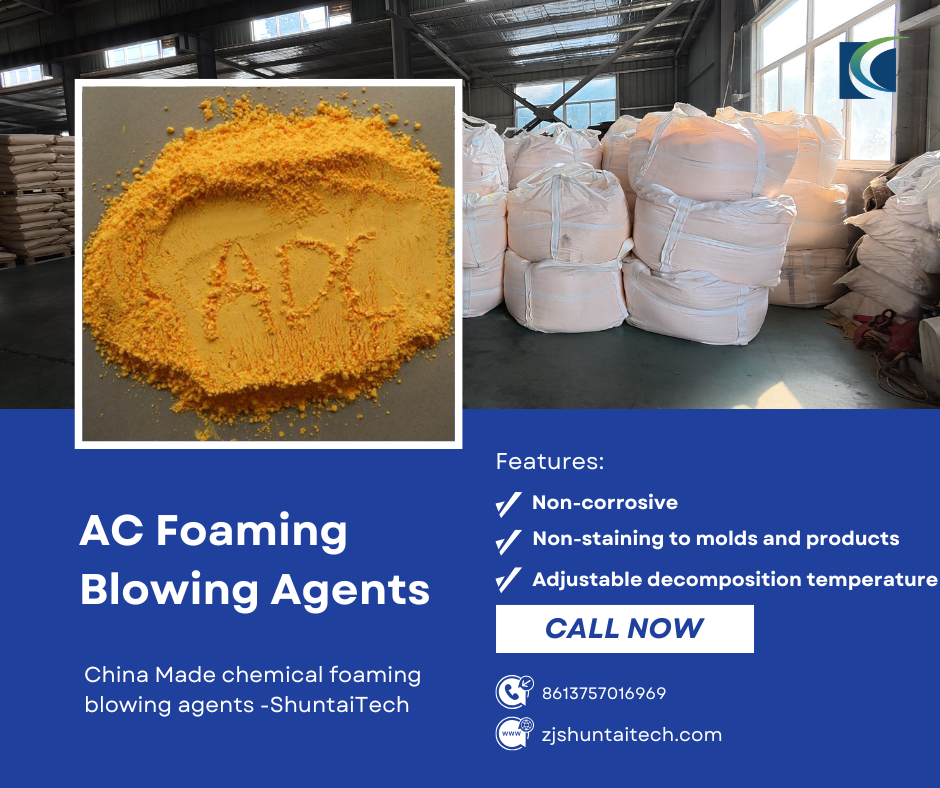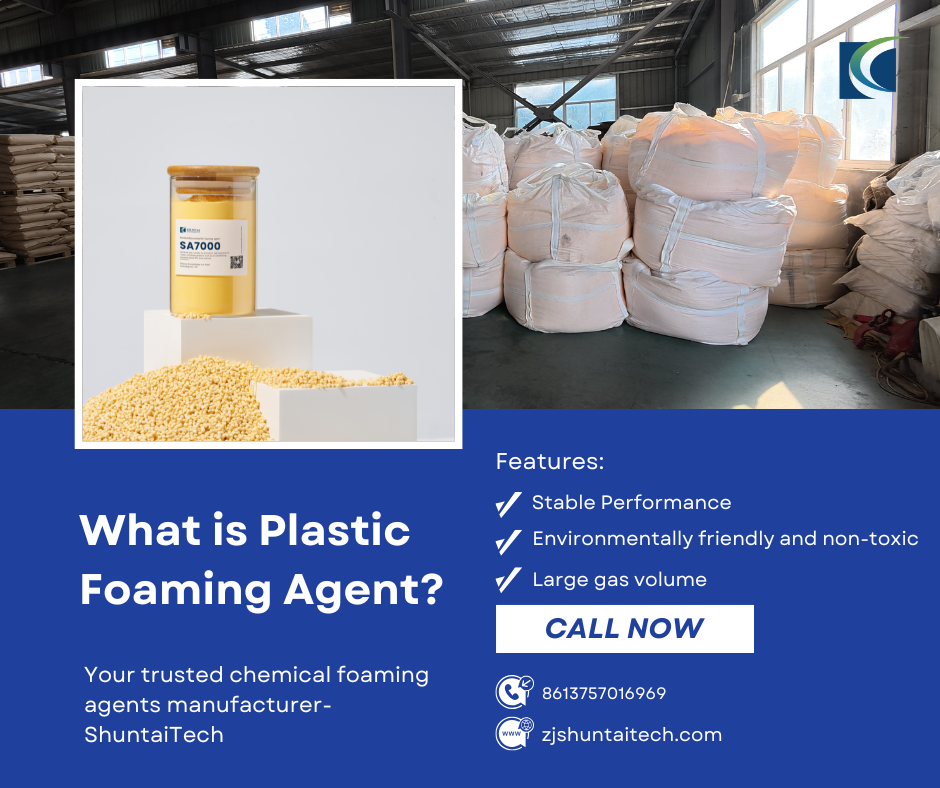In our daily life, we often come into contact with various plastic products. Plastic foaming agent is a chemical substance widely used in the plastics industry, mainly used in the manufacture of lightweight, heat-insulating and shock-absorbing foams. With the development of science and technology, the types and applications of plastic blowing agents are constantly expanding, becoming an indispensable part of the modern manufacturing industry.
Definition and Basic Principle of Plastic Blowing Agent
Plastic blowing agent, defined from a professional point of view, is a substance that can decompose or undergo a chemical reaction to produce a gas during the plastic molding process, which in turn causes the plastic to form a porous structure. It is because of it, the original dense plastic can be transformed into a different pore structure, with special properties of the foamed plastic products.
The working principle of plastic blowing agent is mainly categorized into two ways: physical and chemical. The foaming process of physical blowing agent is based on the change of its physical properties. Take low boiling point hydrocarbon physical blowing agent as an example, in the process of plastics processing, through the way of heating and depressurization, so that the original dissolved in the plastic melt of low boiling point hydrocarbon substances to reach the boiling point, and then rapidly gasification and expansion, the formation of bubbles, and ultimately the formation of porous structure in the plastic. This type of foaming is relatively gentle and has little effect on the chemical properties of the plastic, and is often used in the production of plastic products with special performance requirements.
Chemical blowing agent, on the other hand, produces gas through chemical reaction. It can be subdivided into inorganic chemical blowing agent and organic chemical blowing agent. Inorganic chemical blowing agents, such as sodium bicarbonate, will decompose when heated to produce carbon dioxide gas; organic chemical blowing agents, such as azodicarbonamide, will also decompose when heated to release nitrogen and other gases. These gases form bubbles in the plastic melt, which are cured and shaped to give the plastic a foamed structure. The advantage of chemical blowing agents is that the foaming efficiency is high, and the foaming process and foam structure can be precisely controlled by adjusting the formula and reaction conditions.

Physical blowing agents
Physical blowing agents are blowing agents that utilize their own physical properties (e.g., boiling point, solubility, etc.) to produce gas. Common types of physical blowing agents include low-boiling hydrocarbons, such as pentane, hexane, etc., which have a low boiling point and can be rapidly vaporized under the temperature and pressure conditions of plastics processing; as well as compressed gases, such as nitrogen, carbon dioxide, etc., which are injected into the plastics melt through high pressure, and the gas expands to form a foam when the pressure is released.
The advantages of physical foaming agent are significant. Because its foaming process does not involve chemical reactions, the original properties of the plastic has less impact, and can better maintain the physical and chemical properties of the plastic; at the same time, the foaming process is relatively mild, easy to control, the production process is more stable. However, it also has some shortcomings, such as the risk of gas leakage when using low-boiling hydrocarbons as blowing agents, which may not only cause a waste of resources, but also pose a safety hazard; moreover, the foaming efficiency of the physical blowing agent is relatively low, which may not be able to satisfy the needs of some scenarios that require high production efficiency.
Chemical blowing agents are blowing agents that produce gas through chemical reactions. Among them, inorganic chemical blowing agent is represented by sodium bicarbonate, which is inexpensive and widely available, and the carbon dioxide gas produced by decomposition is safer, and is commonly used in the production of some plastic products with more stringent cost control, such as ordinary foam packaging materials. Organic chemical blowing agents, such as
azodicarbonamide, have high foaming efficiency, can produce a large amount of gas, and can be adjusted by its dosage and decomposition temperature, precise control of the foaming process and foam density, pore size and other parameters, in the production of high-performance foaming plastic products are widely used.
Among many chemical blowing agent suppliers, Shuntai is a chemical blowing agent manufacturer with more than 16 years of experience. Since its establishment in 2008, Shuntai has been specializing in the research, development, production and sales of chemical blowing agents, and has established a leading position in the industry. Whether it is a conventional
azodicarbonamide (AC) blowing agent or a modified AC blowing agent to fit a diverse range of applications, shuntai is committed to meeting our customers' project objectives with standard formulations or special customized solutions.
Shuntai's product range of chemical blowing agents is extremely diverse, covering a wide range of chemical blowing agents such as AC blowing agents, white blowing agents, OBSH blowing agents, H blowing agents, and microsphere blowing agents. For example, SA1000 is widely used in EVA, PE, PVC and other materials, commonly used in the production of EVA sheets, PVC artificial leather, foam boards and profiles; SA3000 is suitable for the foaming of PE, PS, EVA, NBR and other plastics and rubbers, and can be used in a variety of processes, such as extrusion, molding, injection molding, calendering, etc.; SA5000 has fine particle size, uniform foaming and fine pores. SA5000 has fine particle size, uniform foaming, fine pores, and excellent performance in the production of NBR insulation, PVC foam board, shoes and wallpaper; SA7000, as a high-quality AC blowing agent of shuntai, is favored by customers and is suitable for most plastics and rubber products, and it is commonly used in the manufacture of PVC shoes, artificial leather, insulation materials, wallpaper and other products.
Surfactant Foaming Agent
The main function of surfactant foaming agent is to reduce the surface tension of liquid and promote the formation and stabilization of foam. In the process of plastic foaming, it can make the gas more evenly dispersed in the plastic melt, to prevent the bubbles from merging and rupture, so as to improve the stability and uniformity of the foam. This type of blowing agent is usually used in conjunction with physical blowing agents or chemical blowing agents to achieve better foaming results. For example, in the production of high-performance foams, combining surfactant-type blowing agents with chemical blowing agents can make the pore size of the foam finer and more uniform, and improve the mechanical properties and thermal insulation of plastic products.
Wide range of application areas for plastic blowing agents
Packaging Industry
In the packaging industry, plastic blowing agents play a vital role. With its good cushioning performance, foam packaging has become the “guardian” of fragile items such as electronic products, glass products, ceramics and other fragile items during transportation. In the product's outer packaging, for example, the internal foam can effectively absorb the impact of the transportation process to prevent the product from being damaged by collision. At the same time, the lightweight characteristics of foamed plastic products help reduce transportation costs.
Construction Industry
In the construction field, plastic blowing agents are widely used in the production of thermal insulation materials. Polystyrene foam board and polyurethane foam are two common building insulation materials. Polystyrene foam board has good thermal insulation properties and its thermal conductivity is extremely low, which can effectively prevent the transfer of heat and reduce the energy consumption of buildings. Polyurethane foam is not only excellent in thermal insulation performance, but also has high strength and good waterproof performance, commonly used in building walls, roofs and other parts of the thermal insulation, in cold regions, the use of polyurethane foam insulation building, can increase the indoor temperature in winter, while reducing heating costs.
Automotive industry
The automotive industry is also an important application area for plastic blowing agents. In terms of automobile interiors, seats, instrument panels and other parts use a large number of foamed plastic products. Foamed plastic seats have good comfort and support, and can be fitted according to the human body curve, reducing the fatigue of a long ride. At the same time, the use of styrofoam can reduce the weight of automotive parts, thereby reducing the overall fuel consumption of the car. This is of great significance for energy saving and emission reduction as well as lowering the cost of use.
Other Industries
In addition to the above industries, plastic blowing agents are also widely used in furniture manufacturing, sporting goods, aerospace and other fields. In furniture manufacturing, foamed plastics are commonly used in sofas, mattresses and other products to provide a soft and comfortable sitting and lying experience; in sporting goods, the midsoles of sports shoes, the cores of skis, etc. may use foamed plastic products to improve the performance of the products; in the field of aerospace, lightweight and high-strength foamed plastic products can be used in the manufacture of aircraft interiors, satellite parts, etc., to reduce the weight of the aircraft and improve the performance of the flight.
Development trend of plastic blowing agent

High performance
With the continuous improvement of the performance requirements of plastic products in various industries, the performance of plastic blowing agent has also put forward higher standards. In the future, plastic blowing agent needs to have a higher foaming efficiency, can produce more in a shorter period of time, more uniform bubbles; at the same time, to ensure that the foam has a better stability and uniformity, in order to improve the mechanical properties of plastic products, thermal insulation properties. In addition, it is also necessary to enhance the compatibility of the blowing agent with different plastic materials, so that it can be applied to more types of plastic processing, to meet the diversified market demand.
Intelligent and precise control
With the rapid development of science and technology, intelligent control of plastic foaming process and precise regulation of blowing agent performance will become the future development direction. Through the introduction of advanced sensor technology, automation control system and big data analysis, it can monitor and adjust the temperature, pressure, blowing agent dosage and other parameters in the plastic foaming process in real time, realizing the precise control of the foaming process and improving the production efficiency and product quality. At the same time, artificial intelligence technology is used to optimize the design of the performance of the blowing agent and develop new environmentally friendly blowing agent products that better meet specific needs.
Conclusion
As a key material, plastic blowing agent plays an indispensable role in modern industry and daily life. From its definition and basic principles, to its rich and diverse classifications and characteristics, to its wide range of applications, we can see its importance and value. With the improvement of environmental protection requirements, the upgrading of market demand and the continuous progress of science and technology, plastic blowing agent is developing in the direction of environmental protection, high performance, intelligence and precise control. In the future, we have reason to believe that the chemical blowing agents used in the plastics industry will continue to innovate and develop, bringing more high-quality, environmentally friendly, high-performance products to various industries, and continue to improve our lives.

